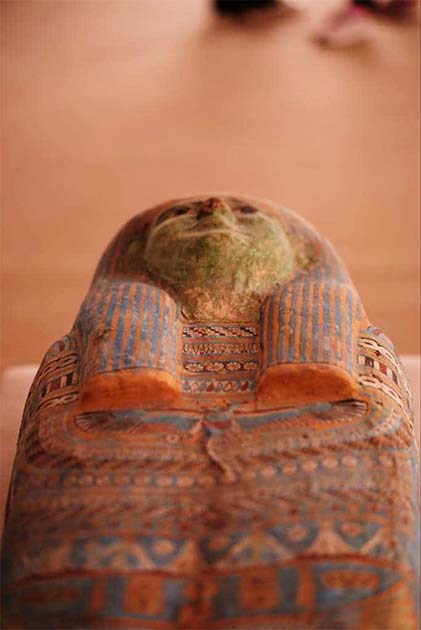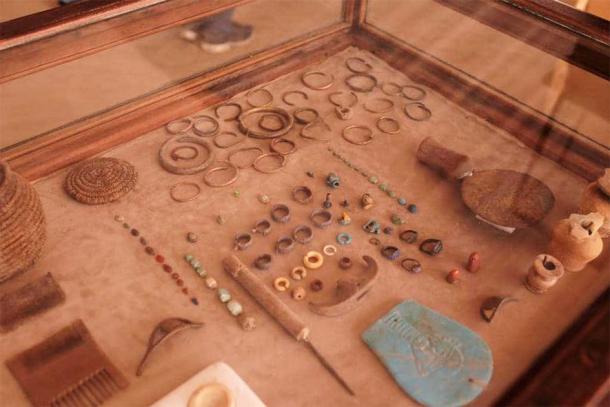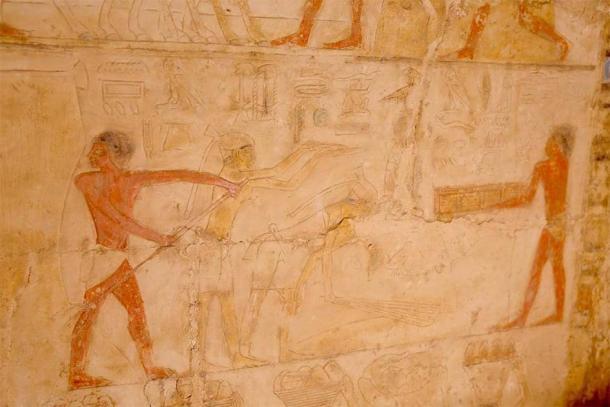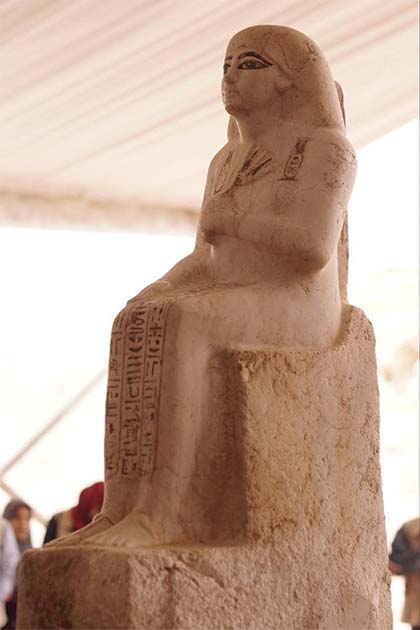
Tombs, Treasures, and Animal Mummies Unearthed in Saqqara Necropolis
Archaeologists in Egypt have announced the completion of their 6th excavation season at the Saqqara necropolis. Not only did they find human tombs filled with artifacts and painted hieroglyphs, but they also discovered workshops where animals were prepared for mummification.
Mr. Ahmed Issa, Egypt’s Minister of Tourism and Archaeology, announced at an international press conference that the discoveries were made at a new archaeological site in the Saqqara Archaeology zone, which is located about 30 kilometers (18 miles) south of Cairo.

A sarcophagus discovered during the latest season of excavations at Saqqara, Egypt. Source: Ministry of Tourism and Antiquities
Featuring several major pyramids, tombs, and temples, Saqqara served as a burial ground for Memphis, the capital of ancient Egypt. Saqqara is perhaps most famous for its Step Pyramid, built by Pharaoh Djoser, which is regarded as the earliest colossal stone building and the first pyramid in Egypt.
The archaeologists discovered animal embalming workshops and human tombs. And according to a press release from the Egyptian Ministry of Tourism and Antiquities, the structures date back to the 30th pharaonic dynasty (380 BC to 343 BC) and to the Ptolemaic period (305 BC to 30 BC).
- Saqqara: A Stunning, Sprawling, Necropolis of Egypt
- Elongated Skulls and Indecipherable Language: What Does the Mysterious Starving of Saqqara Sculpture Mean?

A highly decorated sarcophagus found during the excavations. (Ministry of Tourism and Antiquities)
Beds For The Most Sacred Animals
Previous excavations at Saqqara have revealed intricate wall carvings, funerary objects, and mummified animals. The newly discovered animal embalming workshop was constructed with mud and limestone floors. A number of rooms and halls were found to contain a large number of pottery, linen animal embroidery, and different animal burials.

The tombs contained important funerary objects. (Ministry of Tourism and Antiquities)
Inside one room, the researchers found collections of bronze tools that were used in the animal mummification process. And five stone beds were identified inside the workshop, which are thought to have been used to mummify the most sacred animals.

Archaeologists uncovered many beautiful artifacts. (Ministry of Tourism and Antiquities)
Lady Of The Stars Of The Sky Magic
Mr. Sabry Faraj, the director-general of the Saqqara archaeological site, and the supervisor of the excavations, said that the archaeological mission succeeded in uncovering “the first two tombs of a person called "Ni Hassot Ba." This high-ranking employee of the fifth Egyptian dynasty, which lasted approximately from 2494 BC to 2345 BC, held many religious and administrative titles, but most importantly he was a scribe and priest of the god Horus and the goddess Maat.

Wall painting inside one of the tombs recently unearthed in Saqqara, Egypt. (Ministry of Tourism and Antiquities)
A second grave belonged to “Men Kheber,” who lived during the 18th Dynasty (1549 BC to 1292 BC). Serving as a priest of the god Qadish, the press release says this was “a foreign idol of Canaan origin from the Syrian region who was worshipped in the city of Qadish.” However, this deity was worshipped in 18th Dynasty Egypt as a god of fertility, and “the lady of the stars of the sky magic”.
Imported Trees For Burial Resins
The researchers also found tombs dating to the Old Kingdom (1550 BC to 1077 BC) containing the painted names of the deceased and their wives. In addition, the archaeologists recovered alabaster statues of the dead, painted with blue hieroglyphic writing. The alabaster statue of one tomb occupant, the cemetery owner, is depicted wearing a long robe and sitting on a chair. The report says he is wearing “a hair wig and holding a lotus flower in his left hand, while his right hand is on his thigh.”

The alabaster statue of one tomb occupant is depicted wearing a long robe and sitting on a chair. (Ministry of Tourism and Antiquities)
Analysis later determined that the chemical residues discovered in these tombs were a mixture of “fragrant or antiseptic oils, tars and resins,” according to the Ministry. When all of these paints and resins are brought together and interpreted, including dammar tree resin and elemi oil, the researchers figured out that the raw materials were imported from Asia and other regions in Africa.
- The Magnificent Step Pyramid of Djoser in Saqqara – Now Open!
- Burial Chamber, Snake Goddess and Embalmer Secrets Discovered in Saqqara!
Illustrating Human And Animal Mummification Processes
These latest discoveries come after the 2019 unearthing of a haul of animal mummies containing over a thousand faience mascots, dozens of wooden cat statues, cat mummies, wooden statues, and various animal mummies. Then, in 2020, more than 100 wooden coffins were recovered from inside deep burial wells, including 40 statues of the god of Saqqara, and 20 of the god Horus.
Knowing how animals were buried after being mummified, these new discoveries will better inform archaeologists of “how” animals were prepared for mummification. Furthermore, the human graves add detail to how priests were prepared, and then buried, for their afterlife journeys.

The graves add detail to how priests were prepared, and then buried, for their afterlife journeys. (Ministry of Tourism and Antiquities)
Top Image: Decoration inside one of the tombs recently unearthed in Saqqara, Egypt. Source: Ministry of Tourism and Antiquities
By Ashley Cowie















